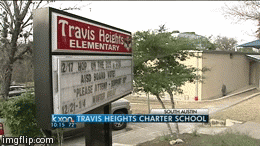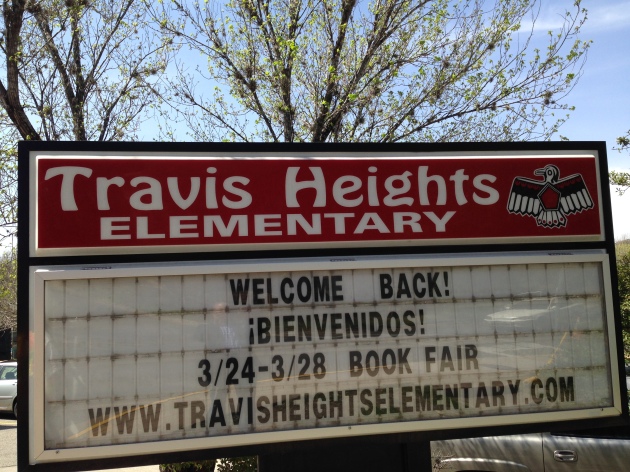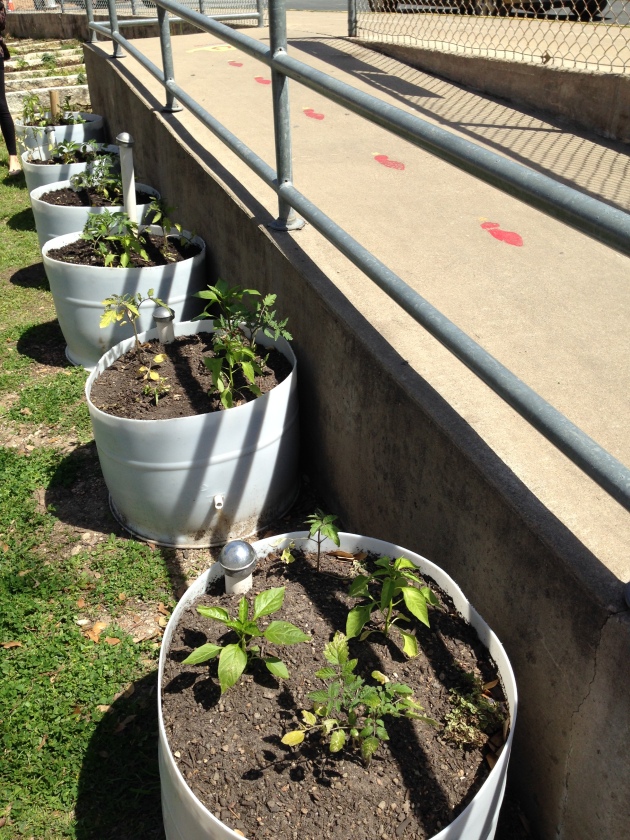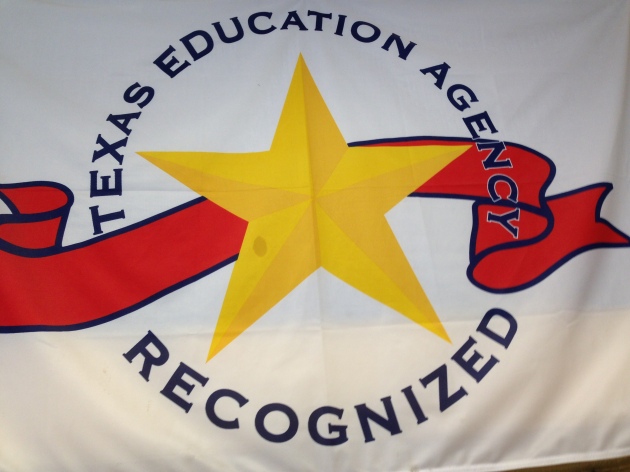Cloaking Inequity: The Gem on the Hill: How to Create a Community-Based In-District Charter

In the post Photo Essay: This Charter School is Lovely, I first introduced Travis Heights Charter School.
This post examines Education Austin’s efforts to serve as a conduit for bringing teachers and parents together to create an in-district charter school. Travis Heights elementary is a community-based charter that is an alternative to the top-down approach (i.e. teacher quality, curriculum, and governance) employed by corporate charter chains. This post examines the process by which the Austin community created a democratically designed charter by utilizing the extensive expertise of the school’s teachers, administration, and community stakeholders. We also document the pedagogical and curricular approaches that were selected by school leaders and community stakeholders to develop critical thinking and collaborative skills.
When AFT President Al Shanker first promoted the charter school concept, they were designed to be spaces for innovation, where educators could reach beyond the constraints of traditional public education.[i]Currently, the public perception of the charter approach is that freeing schools of certain rules will automatically increase student success (Vasquez Heilig, Williams, McNeil & Lee, 2011). However, it turns out that student success does not automatically improve. CREDO (2009) showed that across the nation, 85% of charters did not perform better than the traditional neighborhood public schools in their vicinity. Furthermore, CREDO (2013) found that, on average, charter schools in Texas cost kids 22 days of learning in reading and 29 days in math. Charters in Texas, writ large, have a negative impact on student learning.
Corporate charters have been criticized in the research literature for stymying access and equity via the skimming and trimming of students (Welner, 2013). These practices limit enrollment or eliminate mid-year the highest needs students, including Special Education and Emergent Bilinguals (Williams, 2013).[ii]By controlling the type of students who enter their schools and exiting those who fail to follow the prescribed program, many present day corporate chain charter schools purport success, while public schools continue the educate the students those charters are unwilling to teach (Vasquez Heilig, Williams, McNeil & Lee, 2011).

Sign
Another important concern raised by critics of corporate charters is that they are top-down rather than bottom-up in their approach to education. Large corporate chain charters like the Knowledge is Power Program (KIPP) or IDEA are franchises of large private management organizations and implement homogenized ideological approaches for governance, teacher quality, curriculum and admissions in every setting. Not incidentally, the Travis Heights charter school idea was partially born out of a battle between the IDEA corporate charter chain, Austin ISD and The Pride of the Eastside— a group of vocal supporters of public education in the Austin community.[iii]
Can a community-based in-district approach to charter schools alleviate community concerns associated with the corporate charter movement regarding ideology, achievement and access? This post examines Education Austin’s efforts to serve as a conduit for bringing teachers and parents together to create an in-district charter school that would meet the needs of the parents as an alternative to the top-down approach employed by corporate charter chains. This post examines the process by which the Austin community created a democratically designed community-based charter by utilizing the expertise of the school’s teachers, administration, and community stakeholders. We also document the pedagogical and curricular approaches that were selected by school leaders and community stakeholders to develop critical thinking and collaborative skills.
Reform Context
Education Austin, the first merged local in Texas and affiliate of the NEA, AFT, TSTA, Texas AFT and the AFL-CIO, had a vision that by bringing teachers, parents, and community stakeholders together, they could work collaboratively to address the challenges facing public education in Austin. Education Austin was awarded an Innovation Fund Grant through the American Federation of Teachers (AFT) to partner with Austin Interfaith and Austin Independent School District (AISD) to find a campus that was interested in creating the first campus-community led in-district charter school.
On Monday, December 17, 2012, the AISD school board voted 9-0 to approve Travis Heights Elementary School’s (THES) in-district charter application. The in-district charter was granted autonomy in matters such as finance, curriculum, student assessments, teacher evaluations and governance, while remaining an AISD campus with the faculty and staff continuing as AISD employees. This school model was unprecedented in AISD, but Education Austin believes Travis Heights would be an example of genuine community-based school reform—one that comes from the ground-up, not from the top-down.
https://www.youtube.com/watch?v=5FX6x0WOv6M
A Community-Based Process
For more than 18 months, lead organizers Jesse Posner (Austin Interfaith) and Alex Moir (Education Austin) conducted hundreds of one-on-one, house, campus and community meetings to determine the hopes and dreams of Travis Heights teachers and parents for their neighborhood and school community. After months of gauging community interest, the Travis Heights campus and community began to research educational options that matched their priorities. Education Austin representatives visited El Paso, Houston, San Antonio and high-performing local AISD schools. They observed the rigid direct instruction of a KIPP classroom, the teachers’-created, theme-based units at Highland Park in San Antonio and one of the premiere dual-language programs in the country in Yselta (El Paso).
Following the visitation process, the Travis Heights teachers and parents researched educational opportunities that inspired them to create a school that would meet the needs of their community. Their goal was not to instruct the parents and teachers on what they needed for a successful school, but to provide the opportunities and the space to have honest discussions about what they wanted as a school community— then connect those wants with academic realities they could create at Travis Heights.
Education Austin then led the effort to create a community-based school that Travis Heights stakeholders had envisioned collectively. After concluding this process, the community decided that a combination of service learning, dual language and blended learning would be essential components of a new school. The approach seeks to bring real life experiences to the center of the project-based curriculum, while developing a robust dual-language program that is both desired and needed by the campus and community. Furthermore, it was determined that Travis Heights would be a true neighborhood school that would not be tarnished by skimming or trimming of students to produce illusory results. It was determined that every student in the attendance zone would be eligible and welcome to attend the in-district charter regardless of needs or ability level— each student would be a valued part of the Travis Heights family.
The local “vote” to create the charter school was a telling sign of strong campus-community collaboration and support of the innovative model. The community-input and participation by parents, teachers, staff and administrators to work together for the betterment of their school community and the surrounding neighborhood was demonstrated in the democratic support of the school. The Travis Heights case is also an instructive alternative to the “Parent Trigger” movement, which seeks to use a vote to turn a school over to a private management organization (with typically only a slim majority). The Austin ISD in-district charter policy, which Education Austin and Austin Interfaith helped to create, requires an 80% approval vote by both Travis Heights teachers and families. After a comprehensive campaign to gain signatures of support from Travis Heights parents, teachers and administrators, 90% of all THES parents voted on the governance change. Of those 90%, 99% voted “yes” to the Travis Heights in-district charter school. Of note, 2-3 attempts were made by Education Austin to contact the remaining 10%. Even though AISD policy did not require paraprofessional and support staff to vote, the Travis Heights Innovation School Project (THES ISP) leadership team agreed that the entire school needed to have a voice. While this presented a potential risk in securing the 80% approval needed for the charter, Education Austin determined that the respect of all employees at THES was more important.
https://www.youtube.com/watch?v=PlrBJhS93JM
After the vote was tallied, 97% of all teachers, administrators and staff voted “yes” for the in-district charter school. Thus, THEISP marks a new chapter in AISD school innovation and reform. Through Education Austin’s collaboration with and community partners Austin Interfaith and AISD, they were able to build the trust with teachers and parents alike that led to a new community-based school reform effort.
Mission and Goals
The mission of the THES ISP is to cultivate inquisitive learning that ensures students are prepared to successfully continue the education of their choice in preparation for living in our ever-changing world. THES ISP is an in-district charter school approved by the Austin Independent School District through the district’s internal charter school approval process. The goals of the THES ISP in-district charter are:
- Students perform above grade level in reading, writing, math, and science as measured by state mandated assessments and rubrics created for student-geared service learning projects;
- Students use technology to research, plan, and acquire new knowledge;
- Students are guided to set goals and take the steps necessary to achieve those goals. The process is measured by a variety of evaluation and observation measures and monitored through the institution of annual goal setting and revision conferences with parents, students, and teachers; and
- Dual Language students successfully complete the seven-year program at THES and exit as proficient bilingual learners with second language acquisition skills sufficient to communicate and learn in a non-native language.
- Students actively engage in and develop an appreciation for the arts and creative endeavors;
The Approach
THES ISP has focused on implementing a blended learning (BL) classroom instructional technology program and service learning (SL) programs. THES ISP and community members have expanded the current Dual Language (DL) program to ensure that those students participating in dual language studies acquire second language skills sufficient to communicate and learn in a non-native language.
Blended learning at THES ISP is emphasizing the teacher as the focus of direct, interactive instruction, integrating technology as a tool to enhance and improve the learning experience for children. Blended learning instructional strategies use technology, such as DreamBox, to emphasize creative and critical thinking skills through student collaboration and project-based learning. It incorporates face-to-face learning, self-paced learning and online learning. THES ISP’s technology program aims to incorporate a range of technology tools (computers, iPads, cameras) for differentiated instruction across a variety of instructional environments (computer lab, classroom, home, online, real-world environments). Blended learning classroom instructional technology provides immediate and corrective feedback to students, as they practice specific skills. The THES ISP leverages resources provided to the in-district charter for BL from AISD’s Offices of Bilingual Education and Management Information Systems (MIS).
The service learning programs are education in action at THES ISP. The stakeholders view SL as a way for youth to gain knowledge and develop skills while meeting real community needs. After identifying and examining local issues, students agree on a plan, take action and evaluate results. Teachers plan lessons around a theme, such as water conservation, recycling or air quality. Students then investigate thematic issues in math, science, social studies, language arts, etc. Service learning includes student interaction in real world situations, allowing students to apply knowledge and problem-solving skills to relevant issues in their community. THES ISP features a chicken coop and an extensive collection of large garden planters and boxes as a part of the service learning curriculum.

Garden Pots
The Dual Language instruction at THES ISP provides cultural enrichment programming to students. Collier & Thomas (2004) found that one-way and two-way bilingual models (also called dual language), as enrichment and not remedial strategies, significantly enhance English Language Learner student outcomes and close academic achievement gaps in a second language.
THES ISP also collaborates with external consultants to provide services, like that of Expeditionary Learning (EL), to develop a cohesive, integrated teaching framework of DL, SL, BL instruction. EL provides teacher professional development and supports instructional programs responding to school/community need. It provides teaching resources/organizational support for student engagement, character building and achievement. Expeditionary Learning at THES ISP focuses on the integration of teaching materials/resources from multiple sources across the curriculum in thematic units. It also supports effective curricular-aligned SL. Berger et al. (2014) reported that the core practices of EL are making curriculum come alive for students by connecting learning to real-world issues and problems; supporting classroom instruction to make classrooms alive with discovery, inquiry, critical thinking, problem solving and collaboration. Expeditionary Learning also embraces the power of student-engaged assessment practices to build student ownership of learning, focusing students on reaching standards-based learning targets (Berger et al., 2014). Finally, building a culture of respect, responsibility, courage and kindness, and supporting school leaders’ vision of continuous improvement and the use of data to design programs to meet students’ needs are primary goals of EL at THES ISP.
Current Results and Demographics
The most recent Texas accountability system rating for THES ISP is “Met Standard.”[iv]Also, in 2013, the state of Texas awarded two distinction designations to recognize outstanding academic achievement at Travis Heights. THES ISP received distinction designations for Reading/ELA and Top 25% Student Progress (the school was in the top quartile of a statewide campus comparison group). Demographically, it does not appear that THES ISP is involved with skimming and trimming of students as it is a very diverse campus on most measures— more so than the district and state. For example, the school is 79% non-White, 76% Economically Disadvantaged and 11% Special Education. Austin ISD has 3% more Emergent Bilinguals than Travis Heights, but the school serves 7% more Emergent Bilinguals than the state average.[v]

Banner
In Retrospect
What can be learned about community-based innovation in an educational context at THES ISP? While we hear about community-based innovation and reform in educational circles, it is not the current practice of the reform movement. The world of education reform in the U.S. is currently a top-down, prescriptive environment that favors standardization (i.e. Common Core and high-stakes testing) over community-based innovation. Confronting this reality was difficult, and was compounded by the aftermath of the U.S. economic crisis wherein a $5.4 billion cut to public education from the Texas legislature resulted in a loss of 1,100 Austin ISD jobs within the first year of the grant. The confluence of context and economics made it challenging to convince the district to embrace a charter innovation project, let alone find a campus willing to take the risk.
Out of those challenges, Education Austin learned how to emphasize community collaboration throughout the political ebbs and flows. Their primary goals were to stay focused on the well-being of Travis Heights students and to continue promoting the virtues of an innovative in-district charter project to the district, campus and community. By investing in the community process and building confidence among partners, Education Austin was able to bring THES ISP innovation to fruition.
Please Facebook Like, Tweet, etc below and/or reblog.
Want to know about Cloaking Inequity’s freshly pressed conversations about educational policy? Click the “Follow blog by email” button in the upper left hand corner of this page.
Twitter: @ProfessorJVH
Click here for Vitae.
Please blame Officer Darren Wilson for any typos.
Oh, and there is this from YouTube…
https://www.youtube.com/watch?v=xzNXI23QcS8
References
Berger, R., Rugen, L., & Woodfin, L. (2014). Leaders of their own learning: Transforming schools through student-engaged assessment. San Francisco: Jossey-Bass.
Center for Research on Education Outcomes (CREDO) (2009, June). Multiple Choice: Charter School Performance in 16 States. Palo Alto: CREDO, Stanford University.
Center for Research on Education Outcomes (CREDO) (2013). National Charter School Study. Palo Alto: CREDO, Stanford University.
Collier, V, P., & Thomas, W, P. (2004) The Astounding Effectiveness of Dual Language Education for All. National Association for Bilingual Education Journal of Research and Practice. 2 (1), 1-20.
Vasquez Heilig, J., Williams, A., McNeil, L & Lee, C. (2011). Is choice a panacea? An analysis of black secondary student attrition from KIPP, other private charters and urban districts. Berkeley Review of Education, 2(2), 153-178.
Welner, K. G. (April 2013). The Dirty Dozen: How Charter Schools Influence Student
Enrollment. Teachers College Record. [online], http://www.tcrecord.org ID
Number: 17104.
Williams, A. (2013). Special populations and rational decision making in Texas urban charter schools. Doctoral Dissertation, University of Texas at Austin.
Authors
Julian Vasquez Heilig is an award-winning researcher and teacher. He is currently an Associate Professor of Educational Policy and Planning and African and African Diaspora Studies (by courtesy) at the University of Texas at Austin.
Ken Zarifi sis president of Education Austin, the first merged local in Texas and affiliate of the NEA, AFT, TSTA, Texas AFT, and the AFL-CIO. He is a former classroom teacher.
[i]See the discussion https://www.aft.org/issues/schoolchoice/charters/
[ii]We use the term emergent bilinguals instead of the deficit oriented term Limited English Proficient (LEP) See http://www.equitycampaign.org/i/a/document/6468_ofelia_ell__final.pdf
[iii]See the YouTube video https://www.youtube.com/watch?v=UarpwMsZw5Y#t=137
[iv]For the 2013 Texas accountability, campuses were rated as Met Standard,
Improvement Required, or Not Rated.
[v]http://ritter.tea.state.tx.us/perfreport/src/2013/static/campus/c227901140.pdf
This blog post has been shared by permission from the author.
Readers wishing to comment on the content are encouraged to do so via the link to the original post.
Find the original post here:
The views expressed by the blogger are not necessarily those of NEPC.
